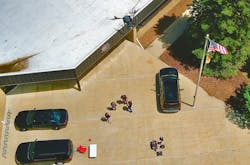More and more law enforcement agencies have purchased Unmanned Aerial Systems—also known as drones—over the last few years, while many others are planning on launching programs of their own in the near future. There are many things to consider when it comes to standing up a drone program from training to equipment.
Chad Collier, Chief UAS Pilot, and James Bushey, UAS Equipment Specialist, both with Adorama Business Solutions, which helps public safety departments purchase and adopt drone technology, offered some suggestions, tips and insights that law enforcement agencies can keep in mind when starting up their own program.
1 Take time planning
Bushey, who also is chief of the Linn Police Department in Wisconsin, says his agency is about six years into its drone program. He says that initially, a lot of the planning went into getting a knowledge base to start the program, including what training and equipment would be needed.
“We spent the better part of a year mapping out what our drone program was going to be utilized for. How are we going to leverage this technology to offset the lack of manpower?” he says. “For us, we’re a mix of a rural area and a lake area so we have a lot of drownings and water-related incidents each year, along with a lot of missing people calls and those types of situations.”
Agencies must consider the probability versus the possibility of use when planning, Bushey stresses. “We originally thought we would be doing a lot of on water deployments of life jackets, so we built a system that would have that capability and I’ve yet to do that. When it came to our second round of drones, we didn’t focus so much on that.”2 Map out problem areas
It’s important for agencies to do hazard mapping, notes Collier, who served for more than 10 years in law enforcement in the state of Michigan. They must understand the different environments throughout their region that they will be operating in. Are there zones that are going to have significant radio interference? He recently helped train an agency in New Jersey that is developing their program from scratch. They went through the initial ground school and then took the drones out and tested the limits of the region they would be operating in.
“As part of that, we were able to help them identify a couple dead zones within their city. A neighboring agency actually lost a drone that fell right out of the sky a few weeks prior to us coming out to do this training,” he says. “That same area happened to be where they were planning to do one of their first events with the drones for the Fourth of July and we were able to help them identify that there was in fact significant interference. They were able to troubleshoot and prepare and relocate where they were going to do the operations to monitor a large-scale event like that.”
3 Buy the right equipment
Collier stresses that one of the major points agencies must understand is its equipment’s capabilities. This includes the types of events the agency is looking to capture whether the agency is located in an urban or rural environment. “Obviously, if you are working in a densely populated urban area, there are definitely going be different considerations based on the size of the drones and the type of use cases and events you are looking to capture in those types of situations.”
What is the agency looking to capture? Will the drones be for search and rescue, tactical overwatch or to monitor large events? Collier says the duration of the events that agencies are looking to capture with the drones must be considered, along with an understanding for the working environment.
“When it comes to drones and developing programs, it should be thought of as a toolbox,” he says, adding that agencies must understand that one system won’t do it all. “Different drones have different advantages. If you are in a densely populated area, putting a 30-pound drone up over hundreds of people, there are risks involved. Additionally, you aren’t going to try to fit a drone that is 3 feet wide weighing 15 pounds through a doorway and use that to clear a house during a tactical operation.”
4 Understand your drones
The ability of an agency to understand the capabilities of their drones is huge, says Collier. “We hear about agencies on a regular basis that run out and buy the latest system and don’t understand how to use that tool to their advantage. It ends up sitting on a shelf and the agency loses interest.” He adds that sometimes, agencies think they need to upgrade their drone fleet when their current drones may have some of the same capabilities of the newer ones; they are not aware of what those systems can do. “New systems are coming out and people always want the latest and greatest, but sometimes they don’t understand the true abilities of what they actually have in front of them. So, that is one piece of it. At the same time, there are definitely new systems that come out that do offer new technology.”
The Linn Police Department currently has three aerial units and one underwater drone. All have been cycled out and the agency is currently on its third round of drones. “With the progression of drones and the technology, I always prepare for the worst-case scenario at three years and plan out about five years,” says Bushey. “Everything is more plug-and-play now. In the old days we had to manually tune thermal sensors and figure out the moving parts to it. It was almost like you needed a cargo van with all of the cases and accessories and charging stuff to make them work and now you can do so much more with the new stuff that comes in a small briefcase size.”
5 Make training a priority
When it comes to training, Bushey says that learning how to operate and adjust all of the features of the drone is extremely important. “Understanding how to fine tune a color pallet in a thermal camera might mean the difference between missing somebody that you were looking for.”
He notes that officers must understand the airspace they are working in, especially when they are working side-by-side with other agencies; avoiding close calls or the bad calls where they get too close coming back in and out of the same working space for the landing and takeoff. He also talked about the importance of training for high-stress events. “In a drone search and rescue, whether it’s for a missing and lost elderly person or more of a tactical situation where you have an armed robbery suspect take off on you, those are all very dynamic situations.”
Bushey stresses the importance of working with neighboring agencies and learning from others. “We learn things all the time, whether it’s cool gadgets and accessories that have helped us out in the field or talking the same language when it comes to search and rescue; how we’re mapping fields and search areas with grids patterns or settings I didn’t realize came in a firmware update.”
While drones are now easier to use as they become more intuitive, he says that proper training is still key. “You can put anyone on one of these expensive drones and teach them how to fly it pretty quickly these days, but how to actually use the equipment to its full extent is another thing. It’s not worth it to have a system if you’re not going to know how to properly use it.”
About the Author
Paul Peluso
Editor
Paul Peluso is the Managing Editor of OFFICER Magazine and has been with the Officer Media Group since 2006. He began as an Associate Editor, writing and editing content for Officer.com. Previously, Paul worked as a reporter for several newspapers in the suburbs of Baltimore, MD.


